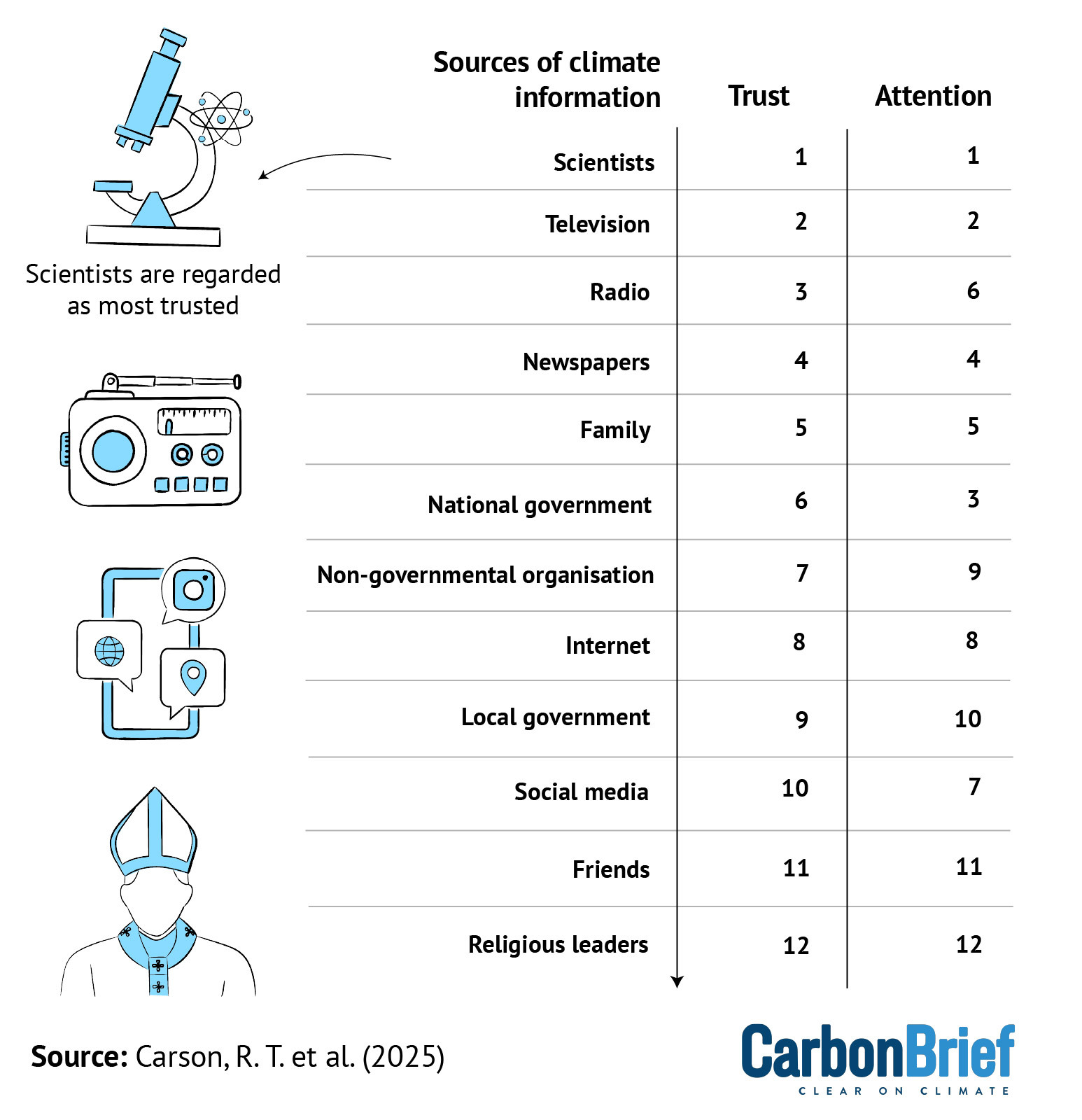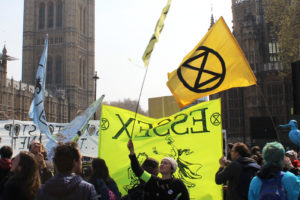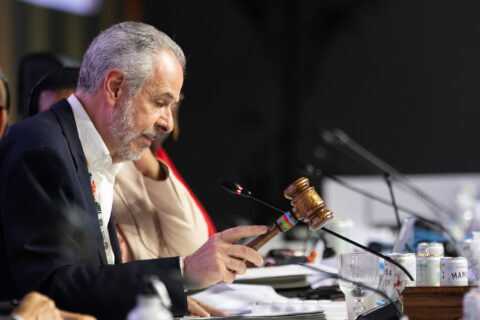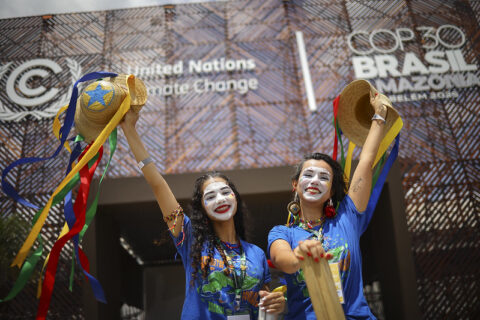Scientists are the most trusted source of information for climate change in some of the largest global-south countries, ranking above newspapers, friends and social media.
This is according to a survey of 8,400 people across Chile, Colombia, India, Kenya, Nigeria, South Africa and Vietnam, the results of which have been published in Nature Climate Change.
The study finds that trusting and paying attention to climate scientists was associated with increased climate knowledge, roughly twice the effect size associated with a college degree.
One scientist who was not involved in the research says the findings suggest there is an opportunity to “bolster climate knowledge” in the global south by widening access to climate science information.
When asked to rank how important climate change is for their country, participants rated the issue as high, with the average score for each country above 4.4.
However, when asked to rank the importance of climate change compared to other key social issues, respondents – on average – ranked taking action on climate change ninth out of 13, after improving healthcare, decreasing corruption and increasing employment.
Another expert not involved in the study says the results highlight a “crucial tension” between “strong” public concern about climate change and the perception that other social issues should take priority when allocating “scarce” public resources.
Global-south focus
The impacts of climate change are disproportionately felt by the poorest members of society, who often live in the global south.
Nevertheless, Dr Luis Sebastian Contreras Huerta – a researcher in experimental psychology at Chile’s Universidad Adolfo Ibanez – tells Carbon Brief that research on climate attitudes has been “heavily biased” toward the global north.
Voices from the global south are “often invisible in science”, he adds.
Huerta was not involved in the study, but has published research using surveys to assess public beliefs about climate change. He describes the new study – which is evenly distributed across Chile, Colombia, India, Kenya, Nigeria, South Africa and Vietnam – as “a valuable attempt to capture public views across Latin America, Africa and Asia”.
The seven countries featured in the research include six of the 20 largest in the global south and range from “the lower end of low-to-middle-income countries (Nigeria) to the low end of high-income countries (Chile)”, according to the study.
The survey was administered online by polling company YouGov between April and May 2023. Respondents could answer in English or in other “country-specific languages”. For example, respondents in Chile and Colombia had the option to carry out the survey in Spanish, while those in India could answer in Hindi.
Trust and attention
The authors asked survey respondents to rank 12 different sources of information about climate change, based on the attention they pay it and how much they trust it.
The average rankings are shown in the table below, where one indicates the highest level of attention or trust and 12 indicates the lowest.

The table shows that, on average, scientists are ranked the highest for both trust and attention.
The country-specific results show that scientists rank the highest in trust in every country except Vietnam, where they rank second highest after television programmes. Meanwhile, friends and religious leaders rank the lowest for trust.
Huerta says it is “encouraging” that the general public “tend to trust scientists as their main source of information”.
However, he warns Carbon Brief about “social desirability” – a phenomenon in which people respond to surveys in a way that they think will be viewed favourably by others. In this case, it means that “people may report higher trust in scientists and less reliance on social media than they actually practice”, Huerta explains.
Dr Charles Ogunbode is an assistant professor in applied psychology at the University of Nottingham. He is not involved in the paper, but has carried out research on public perceptions of climate change.
He tells Carbon Brief that the relatively low attention and trust shown to family and friends is a “remarkable finding that stands in contrast with conventional knowledge”. He continues:
“Previous psychological research on this topic (generally predominated by western samples) would support an expectation that people would have greater trust in interpersonal social referrents like friends and family…
“I think the findings from the study signal an opportunity to bolster climate knowledge in the global south by widening access to scientific information on climate change.”
Climate knowledge
The survey also assesses the level of climate knowledge of the respondents, by asking them to identify whether a series of statements are true, false, or if they are “not sure”.
More than 80% of respondents correctly identified that the following two statements are correct:
- Climate change is mainly caused by human activities.
- Warming leads to more extreme events, such as droughts, floods and storms.
Conversely, fewer than 20% of people correctly identified the following two statements as false:
- Nuclear power plants emit CO2 during operations.
- Today’s global CO2 concentration has occurred in the past 650,000 years.
Knowledge about climate change was “quite similar” across countries, according to the survey. However, the authors found that women are more likely to respond “not sure” than men.
The study finds that trusting and paying attention to climate scientists was associated with increased climate knowledge, roughly twice the effect size associated with a college degree.
Policy comparison
Early in the survey, respondents were asked to rank how important climate change is for their country on a scale from one to five. On average, all countries ranked climate change above 4.4 on this scale.
However, the survey later asked respondents to rank the 13 government programmes, including climate, healthcare and education, in order of importance.
The authors found that “addressing climate change” ranks at ninth, on average, across the seven countries.
Climate change ranks the highest in Vietnam, where it comes in second behind “decreasing political corruption”.
However, it ranks 10th in Nigeria and South Africa, beating only “improving public transport”, “improving access to credit” and “getting Covid-19 under control”.
Lead author Prof Richard Carson, a professor of economics at the University of California, tells Carbon Brief that asking respondents to rank different issues “provides a much richer picture of the structure of public opinion on climate issues” than asking them to rank issues separately. This, he says, is because it forces respondents to make “direct tradeoffs”.
The survey shows that “people might say that dealing with climate change matters – but this does not mean that they would place it on the leaderboard when it comes to priorities”, he adds.
Huerta – the experimental psychology researcher – tells Carbon Brief that results highlight “a crucial tension”. He explains:
“Athough people show strong concern for climate change, when it comes to allocating scarce public resources, priorities such as health, education, poverty reduction, and security often come first.”
He adds:
“People may genuinely care, but without clear, immediate benefits, climate action is often deprioritised – unlike issues such as air pollution, where the consequences and gains are more tangible.”
The authors also asked survey respondents to rank seven “health-related issues”, with respiratory problems consistently identified as the highest priority.
Huerta says the results show a “disconnection”, adding:
“People rank respiratory illness as a top health concern, but they do not always connect it with climate change more broadly. This highlights a key communication challenge for climate policy.”
Finally, the authors asked respondents to rank their preference for the use of a carbon tax. In keeping with the results above, “spend on education and health” ranks top of the list. This is followed by subsidising solar panels and investing in “clean research and development”.
Dr Stella Nyambura Mbau is a lecturer at Kenya’s Jomo Kenyatta University of Agriculture and Technology and was not involved in the study. She tells Carbon Brief that “the preference for earmarking carbon tax revenue for health, education and renewable energy subsidies aligns with community-based adaptation strategies, such as solar-powered solutions, that address immediate needs while building resilience”.
She suggests that prioritising policies that can tackle climate change alongside other social issues could “bridge the gap between climate action and local priorities”.
Next steps
The authors note that their survey could only be completed by people with access to the internet, meaning that it “systematically underrepresents those with lower income, living in rural areas and who are older”.
Only people over the age of 18 were allowed to complete the survey. Across the countries, the median age of respondents was 31 years old. There was also a slight skew towards men, who made up 55% of the respondents.
As such, some external experts pointed out that results could be skewed.
For example, Prof Tarun Khanna, a professor at Harvard Business School, notes that when ranking uses for carbon taxes, there was low support for policies such as returning money to the poor. He questions whether this could be “because the survey concentrates on a relatively affluent class of people”.
Dr Nick Simpson is chief research officer at the University of Cape Town‘s African Climate and Development Initiative Climate Risk Lab and has led separate research on general public perceptions of climate change in Africa.
He praises the study’s “large, cross-national dataset” and “rigorous statistical techniques”. However, he adds:
“The survey questions focus primarily on mitigation [greenhouse gas emissions prevention and reduction] responsibilities, reflecting a global north bias in climate surveys. [The questions] do not fully capture urgent adaptation concerns or the lived realities of climate vulnerability in low and middle-income countries.”
Future research should incorporate more “adaptation-specific questions” in order to “provide a more holistic understanding of climate action priorities”, he says.
The post Scientists are ‘most trusted’ source of climate information in global-south survey appeared first on Carbon Brief.
Scientists are ‘most trusted’ source of climate information in global-south survey
Climate Change
Brazil’s Lula requests national roadmap for fossil fuel transition
Brazil’s President Luiz Inácio Lula da Silva has asked his government to draft by February guidelines for a national roadmap to transition away from fossil fuels, an idea he championed during COP30.
In a directive issued on Monday, the Brazilian leader requested the ministries of finance, energy and environment, together with the chief of staff’s office, to come up with a proposal for a roadmap to a “just and planned energy transition” that would lead to the “gradual reduction of the country’s dependence on fossil fuels”.
The order also calls for the creation of financial mechanisms to support a roadmap, including an “Energy Transition Fund” that would be financed with government revenues from oil and gas exploration.
The guidelines, due in 60 days, will be delivered “as a priority” to Brazil’s National Energy Policy Council, which will use them to craft an official fossil fuel transition roadmap.
At the COP30 climate summit in Brazil, President Lula and Environment Minister Marina Silva called on countries to agree a process leading to an international roadmap for the transition away from fossil fuels, after Silva argued earlier in June that “the worst possible thing would be for us to not plan for this transition”.
Yet, to the disappointment of more than 80 countries, the proposal for a global roadmap did not make it into the final Belém agreement as other nations that are heavily reliant on fossil fuel production resisted the idea. Draft compromise language that would have offered countries support to produce national roadmaps was axed.
Brazil seeks to set an example
Instead, Brazil’s COP30 president said he would work with governments and industry on a voluntary initiative to produce such a roadmap by next year’s UN climate summit, while a group of some 25 countries backed a conference to discuss a just transition away from coal, oil and gas that will be hosted by Colombia and the Netherlands in April 2026.
Experts at Observatório do Clima, a network of 130 Brazilian climate NGOs, welcomed Lula’s subsequent order for a national roadmap and said in a statement it sends signals abroad that Brazil is “doing its homework”.
“President Lula seems to be taking the roadmap proposal seriously,” said Cláudio Angelo, international policy coordinator at Observatório do Clima. “If Brazil – a developing country and the world’s eighth-largest oil producer – demonstrates that it is willing to practice what it preaches, it becomes harder for other countries to allege difficulties.”
The Amazon rainforest emerges as the new global oil frontier
Brazil is one of a number of countries planning a major expansion of oil and gas extraction in the coming decade, according to the Production Gap report put together by think-tanks and NGOs. Much of the exploration is set to take place offshore near the Amazon basin, which is poised to become a new frontier for fossil fuel development.
Significant funding needed
Natalie Unterstell, president of the Brazilian climate nonprofit Talanoa Institute and a member of Lula’s Council for Sustainable Social Economic Development, welcomed the national roadmap proposal in a post on LinkedIn, but emphasised it must tackle Brazil’s goal of becoming the world’s fourth largest oil producer by 2030.
Another key question is whether the Energy Transition Fund it envisages will be large enough to catalyse a real shift over to clean energy, she added. “Small and fragmented tools won’t move the dial,” she wrote.
Some Brazilian states have tested a model similar to the proposal for a national Energy Transition Fund. In the oil-producing state of Espirito Santo, for example, a percentage of the state government’s oil revenues go to a sovereign fund that invests in renewable energy, energy efficiency projects and substitution of fossil fuels with less polluting alternatives.
Colombia seeks to speed up a “just” fossil fuel phase-out with first global conference
Andreas Sieber, associate director for policy at campaign group 350.org, said a meaningful roadmap for Brazil would need to secure “adequate, fair and transparent financing to make the transition real on the ground”.
He also called for “a truly participatory process – involving scientists, civil society, workers whose livelihoods are at stake, and frontline and traditional communities whose rights must be upheld – while ensuring that those with vested fossil fuel interests do not shape the outcome”.
The post Brazil’s Lula requests national roadmap for fossil fuel transition appeared first on Climate Home News.
Brazil’s Lula requests national roadmap for fossil fuel transition
Climate Change
Environmental Groups Demand a Nationwide Freeze on Data Center Construction
In a letter to Congress, the groups said data center development raises concerns about rising energy costs, water use and climate impacts. Many communities are fighting back.
More than 200 environmental organizations signed a letter to Congress supporting a national moratorium on the approval and construction of new data centers. The letter, sent Monday, highlights these centers’ impacts on water resources, electricity rates and greenhouse gas emissions.
Environmental Groups Demand a Nationwide Freeze on Data Center Construction
Climate Change
The Household Choice: Climate Change and the Weight of Everyday Decisions
Climate change is often discussed in global terms, such as the melting of ice caps, rising oceans, and the spread of wildfires. However, the truth is that it begins at home. Every single-family household, whether in the bustle of Toronto, the suburbs of Vancouver, a farming community on the Prairies, or a small northern town, is an active participant in shaping the climate future. The actions we take or fail to take are not isolated. They accumulate, reverberate, and shape the quality of life our children, grandchildren, and great-grandchildren will inherit.
The Myth of Insignificance
Many households believe their contribution is too small to matter. “What difference does it make if I leave the lights on, drive everywhere, or throw food scraps in the garbage? I’m just one family.” But this myth of insignificance is one of the greatest dangers of our time. Each discarded plastic bottle, each unnecessary car trip, each bag of wasted food does not disappear. It piles up, becoming part of the global crisis of climate change. What feels like a private choice is, in reality, a public consequence.
Inaction as a Legacy
Imagine a Canadian family that chooses not to recycle, not to conserve, not to shift their habits. For a year, the consequences may feel invisible. But roll the clock forward. By 2050, their grandchildren in Toronto will wake up to summers filled with weeks-long heat advisories. Schoolyards and parks sit empty in July because it is too dangerous for children to play outdoors. Ontario’s hydro grid is stretched thin due to millions of air conditioners running simultaneously, leading to rolling blackouts. Food prices have doubled as droughts in the Prairies devastate crops, and supply chains falter. Sound familiar? Its already happening across Canada!
Meanwhile, their cousins in Prince Edward Island are coping with rising seas. Entire communities along the coast are gone, washed away by storm surges that happen with increasing frequency. Families that lived by the water for generations have been forced inland, their ancestral homes now threatened by sea rise. This is not exaggeration, climate science paints a stark and very real picture of future coastal realities.
By 2075, their great-grandchildren in northern communities will live with constant water restrictions, as the thawing of permafrost has altered rivers and lakes. Traditional hunting grounds are unsafe because the ice forms too late and melts too soon. Invasive pests and fire scar forests that once provided medicine and food. The Earth around them bears the weight of countless small inactions compounded across time. And when they look back, they see a generation that knew better but refused to change.
Action as a Legacy
Now imagine another Canadian family. They compost, recycle, conserve, and teach their children that every small act of stewardship makes a difference. For a year, the impact may seem modest. But roll the clock forward.
By 2050, their grandchildren in Winnipeg will be growing vegetables in backyard and community gardens, nourished by decades of composting. Energy bills are lower because their homes are equipped with rooftop solar panels and properly insulated to conserve heat in winter and cool in summer. Children still play outside freely because air quality warnings are rare.
Out east, their relatives in Halifax have adapted coastal homes to utilize renewable energy micro-grids and employ storm-resilient design. They continue to live by the ocean, harvesting from healthier waters thanks to decades of careful stewardship and waste reduction. By 2075, their great-grandchildren in northern Ontario communities thrive in local economies powered by clean energy.
Rivers run clearer because they are not treated as dumping grounds. Indigenous and non-Indigenous households work together in climate-adaptive food systems, including greenhouses, hydroponics, and land-based harvesting, to ensure food security without overburdening ecosystems. This family’s small actions, multiplied over decades, became part of a collective movement toward renewal.
The Full Cycle of Consequence
Every household action has a cycle. Throwing out food waste creates methane gas, which accelerates global warming, intensifying storms that flood homes, including those in Montreal, Calgary, and Fredericton. Driving when public transit is available contributes to emissions, which in turn lead to hotter summers in Ottawa, resulting in higher cooling costs, increased strain on the grid, and potentially blackouts during heatwaves. Buying fast fashion creates textile waste that ends up in Canadian landfills, similar to those outside Vancouver or Edmonton, polluting soils and waterways long after today’s wearers are gone.
The cycle is relentless, and it all begins with decisions made in the privacy of the household. What we must recognize is that there is no neutral choice. Every action either adds to the problem or contributes to the solution.
Looking Generations Ahead
The question is not whether a single-family household can “solve” climate change. It cannot. The question is: will this household’s actions add to the burden or lighten it? Will future children, grandchildren, and great-grandchildren wake each morning in a Canada that is habitable and thriving, or one that is hostile and diminished?
To answer this question, every family must reflect on what kind of ancestors they want to be remembered as. Because, in truth, the climate crisis is not just about us; it is about them.
Blog by Rye Karonhiowanen Barberstock
Image Credit :Olivie Strauss, Unsplash
The post The Household Choice: Climate Change and the Weight of Everyday Decisions appeared first on Indigenous Climate Hub.
The Household Choice: Climate Change and the Weight of Everyday Decisions
-
Climate Change4 months ago
Guest post: Why China is still building new coal – and when it might stop
-
Greenhouse Gases4 months ago
Guest post: Why China is still building new coal – and when it might stop
-
Climate Change2 years ago
Spanish-language misinformation on renewable energy spreads online, report shows
-

 Greenhouse Gases2 years ago
Greenhouse Gases2 years ago嘉宾来稿:满足中国增长的用电需求 光伏加储能“比新建煤电更实惠”
-
Climate Change Videos2 years ago
The toxic gas flares fuelling Nigeria’s climate change – BBC News
-

 Climate Change2 years ago
Climate Change2 years ago嘉宾来稿:满足中国增长的用电需求 光伏加储能“比新建煤电更实惠”
-

 Carbon Footprint2 years ago
Carbon Footprint2 years agoUS SEC’s Climate Disclosure Rules Spur Renewed Interest in Carbon Credits
-
Climate Change2 years ago
Why airlines are perfect targets for anti-greenwashing legal action











